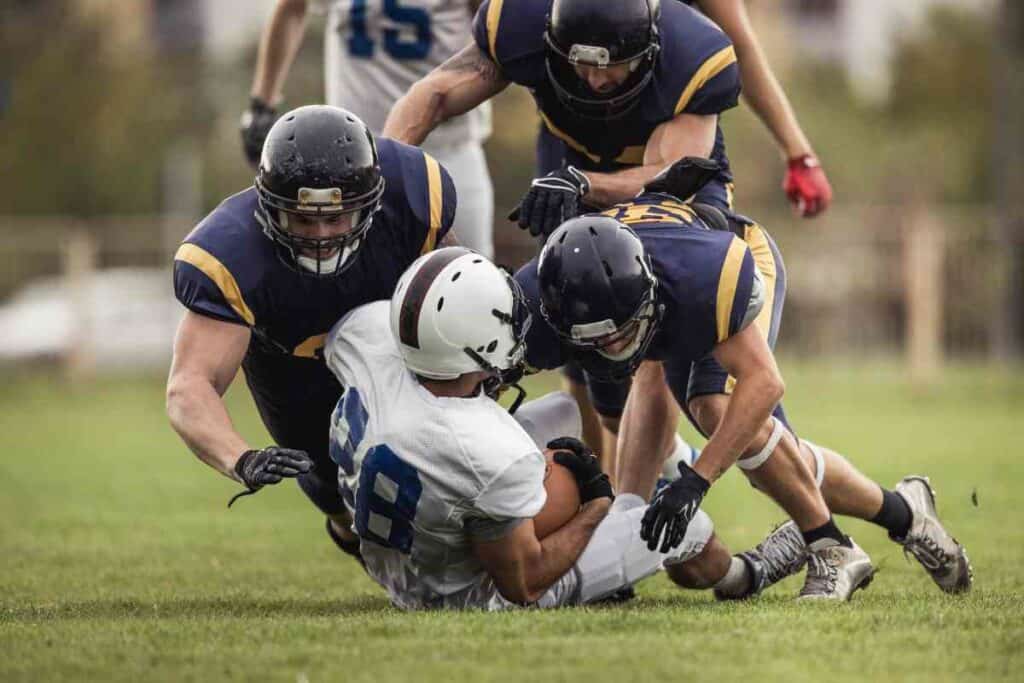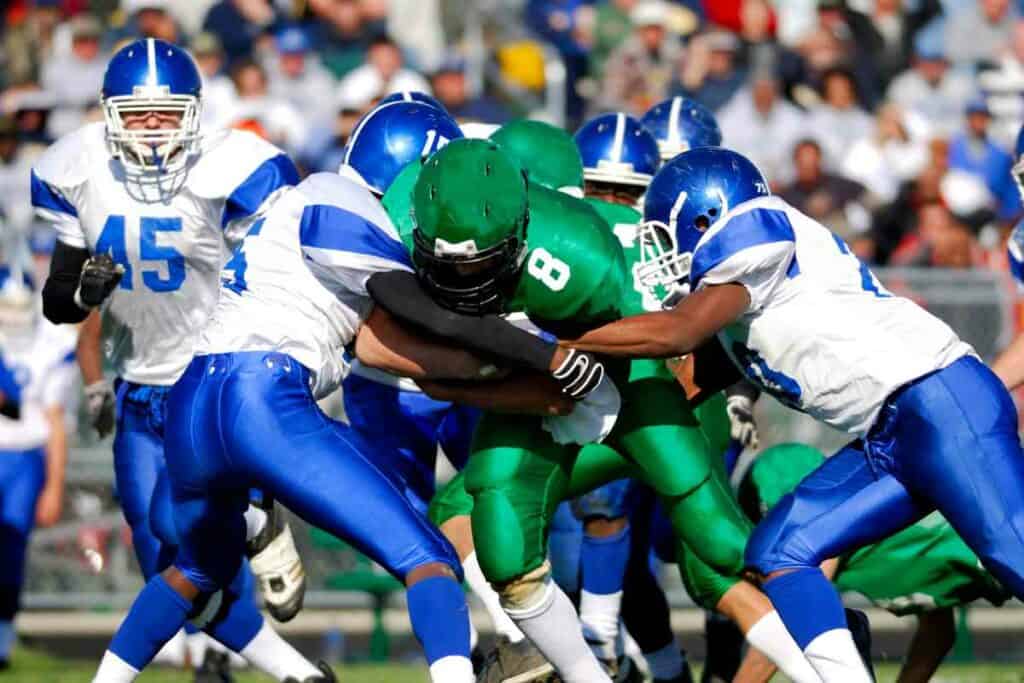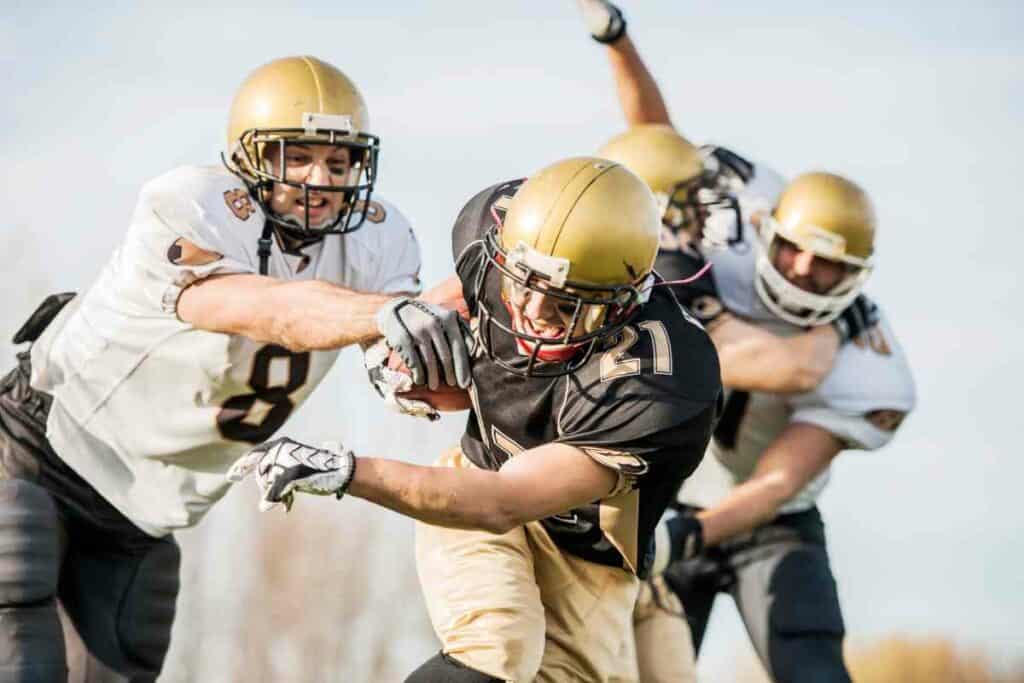What Are the Defensive Positions in Football: A Comprehensive Guide
Football, often seen as an electrifying blend of strategy and raw athleticism, is made even more thrilling by its robust defense system. To truly grasp the sport’s depth, understanding the defensive roles is pivotal. Each player on the defensive side, all 11 of them, is a cog in a machine designed to halt the adversary’s progress.

Dive deeper with our guide to the most important positions in football.
What are the defensive positions in football?
Football’s defensive positions are strategically organized into three main units: the Defensive Line, the Linebackers, and the Defensive Secondary. These include roles like the Nose Tackle, Defensive Tackle, Defensive End, Inside and Outside Linebackers, and the Defensive Secondary comprising Cornerbacks and Safeties.
Each defensive position in football collaborates to thwart offensive advancements and protect their end zone.
- Defensive Line: A combination of brawn and brain, disrupting plays from the word go.
- Linebackers: Often called the defense’s quarterbacks, they read plays, anticipate movements, and react with unparalleled speed.
- Defensive Secondary: They may be the last line, but their role is as critical as the first, ensuring that the end zone remains a fortress.
As you navigate through this guide, you’ll gain insights into the significance and responsibilities of each defensive position. From the resilient defensive line holding the fort at the front to the vigilant secondary guarding the aerial realms, discover the intricacies that make football a game of chess on turf.
The Defensive Line: The Frontline Resilience
The defensive line, often the first barrier, specializes in thwarting run plays and unsettling the quarterback.
- Nose Tackle: Positioned at the center, their primary responsibility is to barricade any central run plays, acting as an impenetrable force.
- Defensive Tackle: Located beside the nose tackle, they play a dual role, curbing running plays and exerting consistent pressure on the opposing quarterback.
- Defensive End: On the line’s edges, they ensure that running plays are contained and make the quarterback’s time as uncomfortable as possible.

The Linebackers: The Heart of the Defense
Being a mix of strength and agility, linebackers bridge the gap between the defensive line and the secondary, ensuring that both ground and short aerial threats are covered.
- Inside Linebacker: Dominating the central defensive region, they focus on restricting runs up the middle while also covering short pass attempts to midfield receivers.
- Outside Linebacker: Strategically positioned on the outer edge of the defensive line, they play a crucial role in halting sideline runs, tracking flank-based receivers, and occasionally pressuring the quarterback.
Defensive Secondary: The Aerial Sentinels
This group ensures that the skies above the football field remain locked to the opposition. They handle the deep threats and act as the last line of defense.
- Cornerback: A cornerback’s mission, should they choose to accept it (and they always do), is to stick to wide receivers like a shadow, neutralizing aerial threats before they even begin.
- Safety: Holding their ground deeper in the field, they intercept deep passes, assist in run defense, and ensure that no opposing player gets behind them. They split into two roles:
- Free Safety: Tasked with guarding the deep middle of the field, they’re vigilant against long pass plays.
- Strong Safety: Closer to the line of scrimmage, they are essential for bolstering the run defense and covering tight ends or slot receivers.

Special Teams and Defense: The Unsung Pillars
Football’s charm isn’t just about quarterbacks or wide receivers making highlight reels. It’s also about the strategic interplay of special teams and defense.
Special Teams: Precision Meets Pressure
These are players who shine away from the main spotlight, ensuring field position and scoring opportunities:
- Kicker: Responsible for scoring through field goals and extra points. Their leg’s precision can often be the difference between victory and defeat.
- Punter: Their strategic boots can change the game’s momentum. A well-placed punt can trap the opposing team deep in their territory.
- Long Snapper: The unsung hero who ensures that every kick starts with a perfect snap.
Understanding these defensive intricacies will not only deepen your appreciation for football but will also provide insights into the strategic battles that play out during every snap.

Conclusion
In the arena of football, understanding the defensive positions illuminates the sport’s tactical depth. While touchdowns and field goals often capture the spotlight, it’s the unsung heroes of the defense that often shape the game’s outcome. With a clearer picture of these roles, one’s appreciation for every tackle, interception, and defensive play is bound to deepen.
Frequently Asked Questions
What are the different positions on defense in football?
There are 11 different positions on defense in football, which are divided into three groups: the defensive line, linebackers, and defensive backs. The defensive line consists of the nose tackle, defensive tackle, and defensive ends. Linebackers include inside linebackers and outside linebackers. Defensive backs consist of cornerbacks and safeties.
What is the role of a defensive end in football?
A defensive end is a player on the defensive line whose primary responsibility is to rush the quarterback and prevent the offense from running the ball outside of the tackle box. They also need to be able to read the offense and adjust their positioning accordingly.
What are the responsibilities of a safety in football?
Safeties are defensive backs whose primary responsibility is to cover the deep part of the field and prevent long passes. They also need to be able to tackle effectively and support the run defense.
What is the difference between a cornerback and a safety in football?
Cornerbacks and safeties are both defensive backs, but they have different responsibilities. Cornerbacks primarily cover wide receivers, while safeties cover the deep part of the field and provide support for the run defense.
What is the job of a middle linebacker in football?
The middle linebacker is a key player in the defense who is responsible for stopping the run and covering the middle of the field in pass coverage. They need to be able to read the offense and communicate effectively with their teammates.
How do defensive positions vary in a 4-3 vs. a 3-4 defense in football?
In a 4-3 defense, there are four defensive linemen and three linebackers, while in a 3-4 defense, there are three defensive linemen and four linebackers. The specific responsibilities of each position may vary depending on the defensive scheme being used.
| Position | 4-3 Defense | 3-4 Defense |
| Nose Tackle | Not used | Primary run stopper |
| Defensive Tackle | Primary run stopper | Two-gap defender |
| Defensive End | Pass rusher and run stopper | Pass rusher and contain player |
| Inside Linebacker | Primary run stopper and coverage player | Two-gap defender and coverage player |
| Outside Linebacker | Pass rusher and coverage player | Pass rusher and coverage player |
| Cornerback | Cover wide receivers | Cover wide receivers |
| Safety | Cover deep part of the field and support run defense | Cover deep part of the field and support run defense |
